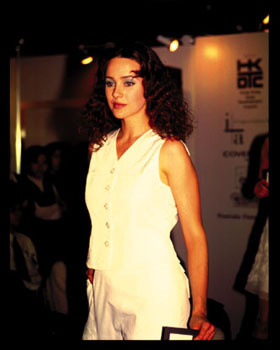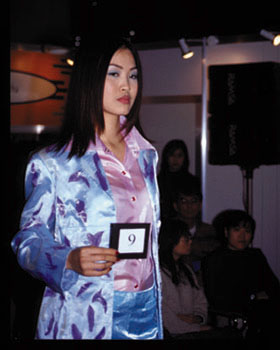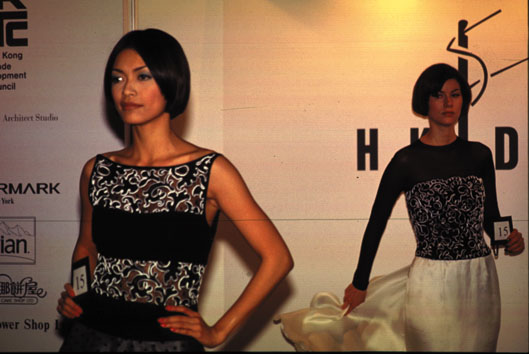 In the name of Hong Kong
In the name of Hong KongLocal designers try hard to catch worldwide attention



 In the name of Hong Kong
In the name of Hong Kong
Local designers
try hard to catch worldwide attention
By Kwok Kar Bo
 cheers and applause, so concluded the 27th Hong Kong Fashion Week in late January.
cheers and applause, so concluded the 27th Hong Kong Fashion Week in late January. Behind the scenes, local designers struggle hard in this small market, and only a few get appreciation worldwide. Mr. Laurence Tang is among one of them.
Already having boutiques in China, Singapore, Japan and London, he recently introduced his designs to Los Angeles.
“Places famous for top designs sometimes regard Hong Kong design as something cheap,” said Mr. Tang.
Some said customers were usually invited to buy Hong Kong clothing because of the low prices, and so they did not care about who designed the garment.
The lack of local market support made it even harder for the fashion design industry to develop.
 “Hong Kong earned high fame in clothes manufacturing simply because it’s a profit making business. But to many here, fashion is only a luxury,” said Mr. Tang.
“Hong Kong earned high fame in clothes manufacturing simply because it’s a profit making business. But to many here, fashion is only a luxury,” said Mr. Tang.
Still it was not an easy task for designers to survive in local market. Probably, it is more difficult to be famous in the international one.
Designer Pacino Wan said: “It is a phenomenon in Hong Kong that local people do not support local designers. Some chose to buy ‘China-made European fashions’, while considering Hong Kong designs to be low class.”
Backing this idea, Mr. Raymond Au, associate professor in the Institute of Textiles and Clothing at Hong Kong Polytechnic University, said, “Paris, London and Milan have their own styles and lead the global trend, but Hong Kong does not. “This is because the establishment of high class fashion in Paris was as early as in the 1860s. People would certainly follow this leading European style,” said Mr. Au.
But as Hong Kong’s counterpart, Japan has been one of the exceptions.
 Mr. Tang traced the reasons.
Mr. Tang traced the reasons.
“During the ’60s and ’70s, a few designers in Japan set up their bases in Paris. They sold the designs directly to customers in Europe.
“In the ’80s, they successfully broke the monopoly of the European fashion world. Now, Japanese design exists in the international market with its own Japanese style,” he said.
However, it seems to be harder for a Chinese “look” to become mainstream in Hong Kong. Mr. Wan said some local designers who created a traditional Chinese look without sound understanding about the Chinese culture would only make it superficial.
“One needs to note the importance of the choice of fabric, the embroidery patterns and their qualities,” he said.
“The style of European designs and the Chinese style are totally different. This traditional clothing, a duplication of clothing design, cannot be considered as fashion,” said Mr. Tang.
Concerning the Chinese-look wave, designer Walter Ma had this to say:
“Sometimes, people have a misunderstanding that ancient Chinese wear represents Hong Kong.
“In fact, Hong Kong is a prosperous city. A Hong Kong look should reflect people’s lifestyles, as well as their own attitudes,” said Mr. Ma.
 For him, a good piece of garment involves the choice of fabric, the cutting, the style, the colour selection and the concept carried with the design.
For him, a good piece of garment involves the choice of fabric, the cutting, the style, the colour selection and the concept carried with the design.
Yet he agreed that the creativity of designers would be inhibited by some practical considerations like marketing.
“Designers want to survive, and, hence, think more about customers’ tastes. It’s especially true for those who stay in this field long,” said Mr. Ma.
Design is differentiated into first line and second line in a designer’s collection.
According to Mr. Tang, the first line is often known by the designers’ names. Like Armani is the first line by Armani, with his second line named Emporio Armani.
“Usually, the second line design is less expensive and more commercialized than the first line. However, the first line can preserve more of the designers’ originality.
“In order to survive, designers have to rely on the second line — that is, to follow the trend.
“Yet there’s less satisfaction for them. In contrast, the first line collection allows greater flexibility for designers to develop their own unique styles,” said Mr. Tang.
Some famous designers have made collections that served artistic purposes rather than commercial ones.
“It’s difficult to identify what is commercial from what is not. Of course, there are designs which are obviously trying to please the buyers. But design with innovative ideas sometimes can also be commercial.
“One can either stick to a rather conservative design, or continually explore more new ideas and technologies, while the latter may not survive best. Yet they do coexist,” said Mr. Ma.
Like Mr. Wan, he likes to involve interesting ideas in his designs. For example, one can sew buttons on the backs of clothes. This design suits the majority of buyers, who may not have supermodel figures.
A new trend for fashion designers is to support environmental protection. Many have tried to utilize natural fibres with dull and natural colours, or to sew pieces of cloth together to create an old, used look in their designs to meet the worldwide concerns.
Moreover, Mr. Au said, “When the so-called Mod look in the ’60s and ’70s comes back in fashion, plastic and genuine and artificial leathers are favourite materials for designers, too.”
Recently, Mr. Wan has been mixing special fabrics, like polyamid — which is both water-resistant and air-permeable, as well as semi-transparent and shiny — in his designs.
Mr. Ma considered the source of fabrics a major limitation to his designs.
“Due to different cultural perceptions, I may have to choose alternative distinctive fabrics for the same design.
“For example, Singaporeans think that shiny cloth must be reserved for evening dress, without noting an international trend to use shiny textiles widely. I have to make some changes according to their demands,” he said.
Quality fabric usually comes from Italy, but some may be from Japan.
Mr. Tang was quite contented with designs in the Southeast Asia market.
His dream is to have his designs distributed in fashion cities worldwide.
“It’s nice to have someone appreciate my designs and cooperate in running a business.
“Personally, I don’t prefer to lower the value of my designs to please others. I enjoy the freedom to do what I really want to,” he said.


